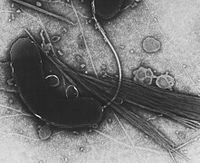
Photo from wikipedia
Ticks are vectors of pathogens affecting human and animal health worldwide. Nevertheless, the ecological and evolutionary interactions between ticks, hosts, and pathogens are largely unknown. Here, we integrated a framework… Click to show full abstract
Ticks are vectors of pathogens affecting human and animal health worldwide. Nevertheless, the ecological and evolutionary interactions between ticks, hosts, and pathogens are largely unknown. Here, we integrated a framework to evaluate the associations of the tick Ixodes ricinus with its hosts and environmental niches that impact pathogen circulation. The analysis of tick-hosts association suggested that mammals and lizards were the ancestral hosts of this tick species, and that a leap to Aves occurred around 120 M years ago. The signature of the environmental variables over the host's phylogeny revealed the existence of two clades of vertebrates diverging along a temperature and vegetation split. This is a robust proof that the tick probably experienced a colonization of new niches by adapting to a large set of new hosts, Aves. Interestingly, the colonization of Aves as hosts did not increase significantly the ecological niche of I. ricinus, but remarkably Aves are super-spreaders of pathogens. The disparate contribution of Aves to the tick-host-pathogen networks revealed that I. ricinus evolved to maximize habitat overlap with some hosts that are super-spreaders of pathogens. These results supported the hypothesis that large host networks are not a requirement of tick survival but pathogen circulation. The biological cost of tick adaptation to non-optimal environmental conditions might be balanced by molecular mechanisms triggered by the pathogens that we have only begun to understand.
Journal Title: Frontiers in Cellular and Infection Microbiology
Year Published: 2017
Link to full text (if available)
Share on Social Media: Sign Up to like & get
recommendations!